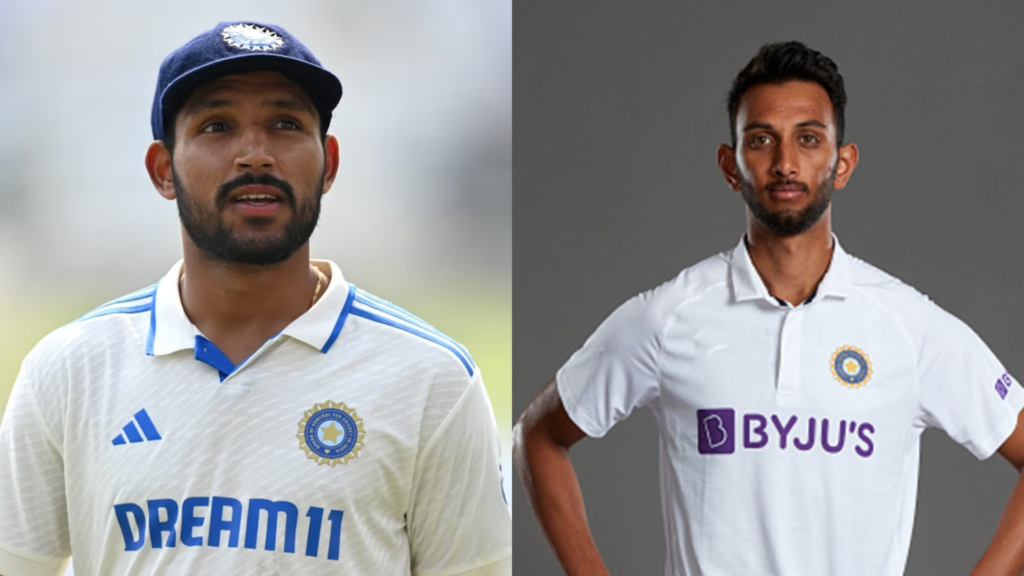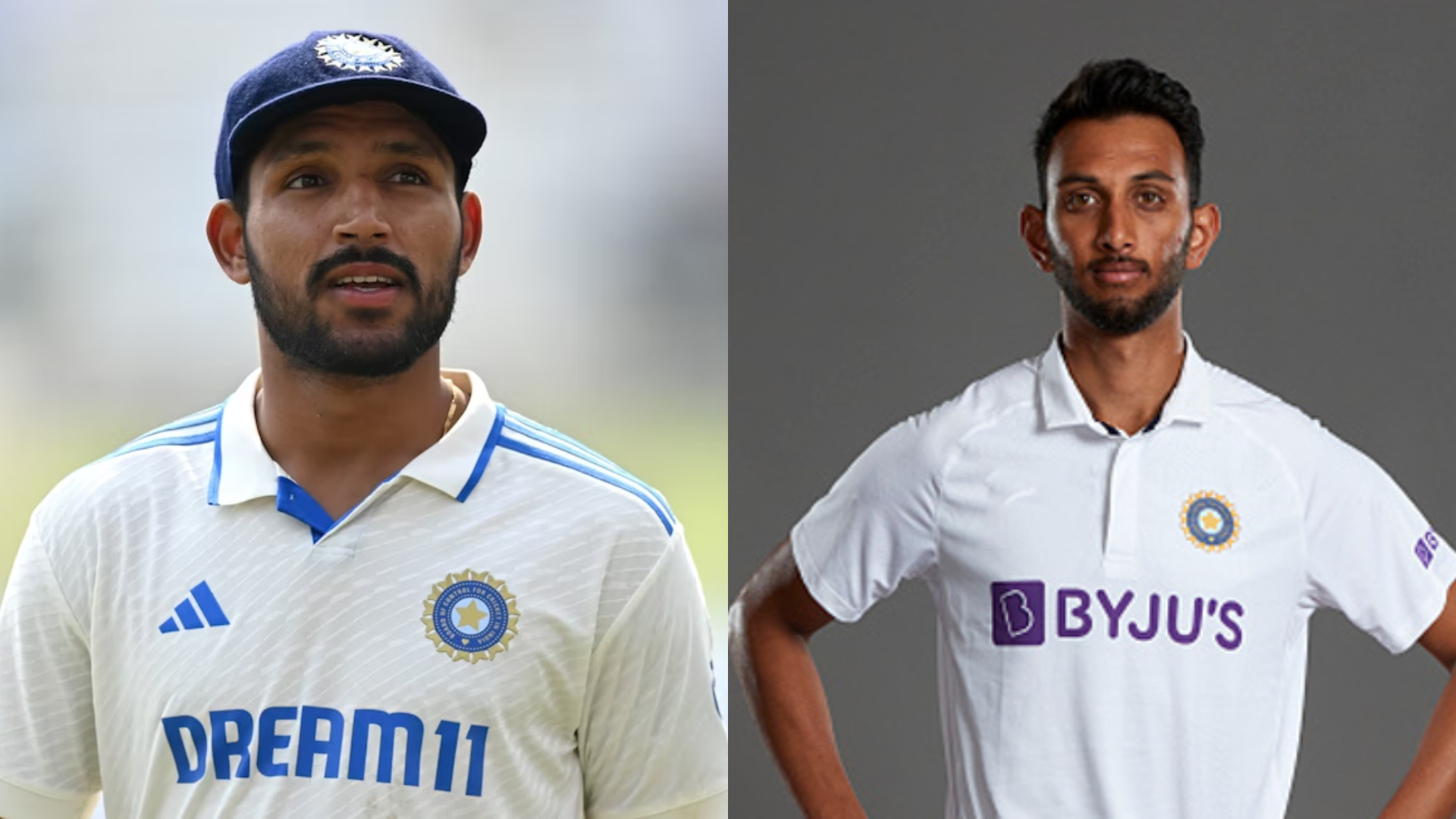With the prestigious Border-Gavaskar Trophy on the horizon, five of India’s Test squad members got an early taste of Australian conditions by playing for India A in two unofficial Tests against Australia A in Mackay and Melbourne. For these cricketers, this exposure to the Australian pitches and playing conditions was invaluable preparation, as it allowed them to sharpen their skills against Australia’s formidable pace and bounce. Here, we review each player’s performance across the two games and assess their potential for selection in the upcoming Test series.
Table of Contents
Abhimanyu Easwaran: Tough Outings in Challenging Conditions (border-gavaskar trophy)
Abhimanyu Easwaran, 29, entered the unofficial Tests in Australia aiming to make a strong case for his Test debut. However, he faced a challenging two-match stint, recording scores of 7, 12, 0, and 17 across four innings. Easwaran’s dismissals reflected his struggles with the additional bounce and pace characteristic of Australian pitches, raising questions about his preparedness for the upcoming Border-Gavaskar Trophy.
In Mackay, he was caught behind while attempting to defend a delivery from Jordan Buckingham, being beaten by the bounce. His challenges continued in Melbourne, where he fell in the very first over, squared up by a rising ball from Michael Neser that found its way to the gully. His final dismissal came at the hands of Nathan McAndrew, with Easwaran edging a tentative drive to gully once again. Such dismissals are concerning, particularly as they hint at a vulnerability to Australia’s elite pace attack, which features bowlers like Pat Cummins, Josh Hazlewood, and Mitchell Starc—players capable of generating even greater speed and bounce.
Easwaran’s struggles emphasize the importance of adaptability and resilience for success in Australian conditions. To earn consideration as a replacement for Rohit Sharma, Easwaran must show he can adjust his technique to handle Australia’s steeper bounce and fast-paced wickets. While his domestic track record is impressive, translating that success to Australian pitches has proven difficult, underscoring that adaptability will be critical if he is to secure a spot in India’s Border-Gavaskar squad.
Despite his challenges, Easwaran’s relevance for the Border-Gavaskar Trophy should not be entirely dismissed. He has shown significant potential in domestic cricket, consistently performing well and demonstrating an ability to construct innings with patience and control. If he can work on adjusting his game to counter the bounce and pace of Australian pitches, his reliability as an opener could add stability to India’s lineup. His adaptability in these tough matches will be a key factor in determining whether he can step up against the world’s best bowlers in one of cricket’s most high-profile series.

KL Rahul: Adjusting to Australian Pitches After Limited Preparation (border-gavaskar trophy)
KL Rahul, a seasoned Indian batsman, entered the unofficial Tests under considerable pressure, having had minimal time to adjust to Australian conditions. Returning scores of 4 and 10 at the MCG, Rahul displayed glimpses of his technical abilities, though he couldn’t fully capitalize on his opportunities. His performance raises questions, but it also highlights his potential relevance for the upcoming Border-Gavaskar Trophy, especially given his experience and adaptability.
In his first innings, Rahul was dismissed by a sharp, seaming delivery from Scott Boland, which he nicked to the slips—a tough ball he was forced to play at due to its angle and movement. Despite this early setback, Rahul appeared more comfortable against the quicks in his second innings. His unfortunate dismissal came at the hands of offspinner Corey Rocchiccioli, who bowled an innocuous delivery that slid through Rahul’s legs onto the stumps, catching him by surprise.
Australian opener Marcus Harris, observing Rahul’s brief innings, remarked on his “class,” noting that Rahul looked solid at the crease, even if the runs didn’t follow. Rahul’s comfort against Australia’s quicks is notable; it underscores the adaptability he brings, which could be valuable for India in facing an aggressive Australian pace attack. While he didn’t score heavily, his experience in similarly challenging conditions, combined with his ability to handle high-quality fast bowling, could make him a viable candidate to replace Rohit Sharma if needed.
For India, having a batter like Rahul, who has prior experience playing against the Australian attack, could be an asset in this Border-Gavaskar Trophy. His adaptability, skill against pace, and calm presence under pressure give him the tools needed to contribute meaningfully, even if he’s been short of runs recently. While his selection may still be up for debate, Rahul’s demonstrated potential to adjust quickly to Australian conditions might be a deciding factor for India as they finalize their squad for this high-stakes series.
Dhruv Jurel: A Standout Performance Showcasing Class and Composure (border-gavaskar trophy)
Of all the players, Dhruv Jurel stood out as the most impressive performer, shining as the best batter across both sides in the second unofficial Test at the MCG. By scoring fifties in both innings, Jurel displayed his capability to handle challenging Australian conditions with skill and confidence, a promising sign for the upcoming Border-Gavaskar Trophy. His outstanding 80 in the first innings was near flawless, showcasing his solid defense, disciplined shot selection, and skillful execution of aggressive strokes like pulls, cuts, and drives—all essential tools for batting success in Australia.
In his second innings, Jurel maintained his resilience, capitalizing on an early life when Australian fielder Ollie Davies dropped him at 25. He used this opportunity to score a composed 68 before eventually getting out while attempting a big shot. His performance against notable bowlers like Scott Boland, Michael Neser, and Nathan McAndrew demonstrated his maturity, technique, and strong adaptability—qualities that enhance his relevance as a potential inclusion for the Border-Gavaskar Trophy.
Jurel’s consistency in the face of Australia’s bowling attack positions him as a solid candidate for a future Test call-up. His adaptability on fast, bouncy tracks sets him apart, especially if concerns arise about Sarfaraz Khan’s ability to handle the pace and bounce of Australian pitches. Adding Jurel as a specialist batter could provide India with an additional layer of stability and strength in the middle order, particularly against Australia’s high-quality fast bowlers.
With his maturity and technical skills already on display, Jurel could be a valuable asset in India’s Border-Gavaskar Trophy lineup, providing an adaptable batting option who can withstand the pressure of Australia’s pace and bounce. His stellar performance in these unofficial Tests has not only highlighted his immediate potential but also reinforced his long-term relevance for India’s red-ball future.
Nitish Kumar Reddy: Inconsistent with the Bat, Limited Impact with the Ball (border-gavaskar trophy)
All-rounder Nitish Kumar Reddy had a modest series with the bat, scoring 0, 17, 16, and 38 across his innings. However, his partnerships with Jurel in Melbourne were valuable, helping to stabilize the team after top-order collapses. Reddy’s 38 in Melbourne showed promise, but his inability to handle the medium-pace bowling of Beau Webster, who dismissed him thrice, indicates room for improvement.
Reddy’s struggles with the short ball are a potential weakness, as he was bounced out three times during the series. With the ball, he had minimal impact, taking only one wicket in 31 overs at a costly economy rate of four runs per over. While he did secure the crucial wicket of Nathan McSweeney in Mackay, his overall bowling performance left much to be desired. Reddy’s inconsistency with both bat and ball may keep him out of contention for the Border-Gavaskar Trophy.
Prasidh Krishna: Dominating Australia’s Batters with Pace and Bounce (border-gavaskar trophy)
Prasidh Krishna emerged as one of the standout performers for India A, making a compelling case for his inclusion in the Border-Gavaskar series. With 10 wickets at an average of 17.30, including an impressive 4 for 50 in the first innings at the MCG, Krishna demonstrated his aptitude for Australian conditions. His combination of accuracy, bounce, and pace troubled the Australian batters consistently, especially opener Marcus Harris, whom he dismissed three times.
Krishna’s two-wicket burst at the start of the second innings in Melbourne rattled Australia A, providing India A with a chance to challenge the hosts. Moreover, his lower-order batting contribution—scoring 29 off 43 balls—underscored his all-round value.
As a tall, right-arm seamer, Krishna’s skill set aligns perfectly with Australian pitches. His ability to extract bounce and maintain a disciplined line and length could be a valuable asset for India in the Border-Gavaskar Trophy.
Implications for India’s Border-Gavaskar trophy Squad
These unofficial Tests in Australia provided the Indian selectors with a deeper insight into the players’ potential to succeed in challenging conditions to play for Border-Gavaskar Trophy. Here’s a summary of each player’s performance and their potential for selection:
Abhimanyu Easwaran
Despite his solid domestic track record, Easwaran’s struggles with the extra bounce in Australia might lead selectors to reconsider his readiness for a Test debut. If Rohit Sharma is unavailable, Easwaran will need to demonstrate better adaptability.
KL Rahul
Although Rahul’s form was not outstanding, his experience and technical soundness could still favor him as a backup option for Rohit. His brief moments of composure against pace reinforce his value as a versatile opener, though his overall readiness may still be in question.
Dhruv Jurel
Jurel’s assured stroke play and consistency make him a strong candidate for a call-up as a specialist batter, especially in Australian conditions. If Sarfaraz Khan’s ability to handle pace is in doubt, Jurel could be a suitable replacement.
Nitish Kumar Reddy
Reddy’s inconsistency may keep him out of contention, as he struggled to make a significant impact with either bat or ball. His performance underscores the need for improvement, particularly in handling short-pitched deliveries.
Prasidh Krishna
Krishna’s exceptional performance has likely boosted his chances of being included in the Test squad. His control, pace, and ability to extract bounce are qualities that could complement India’s frontline pace attack in Australia.
Conclusion
The two unofficial Tests between India A and Australia A have highlighted both strengths and areas for improvement among India’s Test squad members. Dhruv Jurel and Prasidh Krishna emerged as standout players, demonstrating readiness and composure in the face of challenging conditions. KL Rahul, despite limited preparation, remains a viable option, while Abhimanyu Easwaran and Nitish Kumar Reddy will need to address specific weaknesses.
As India prepares to take on Australia in the Border-Gavaskar Trophy, these performances will serve as valuable insights for the selectors. The battle for a spot in the playing XI will be fierce, and the experiences gained in Mackay and Melbourne may prove instrumental in shaping India’s squad strategy as they chase victory on Australian soil.

1 thought on “Border-Gavaskar trophy: India A’s Test Squad Preview,and Evaluating Performances in Australia”